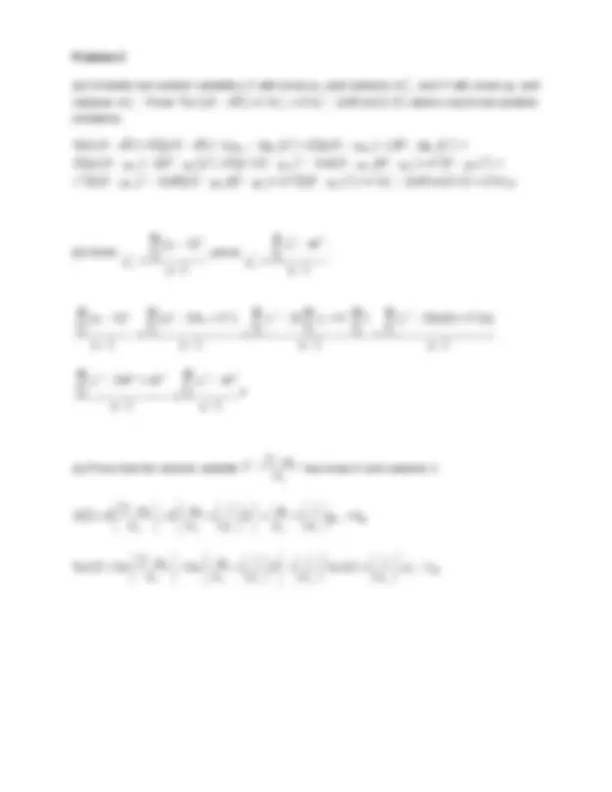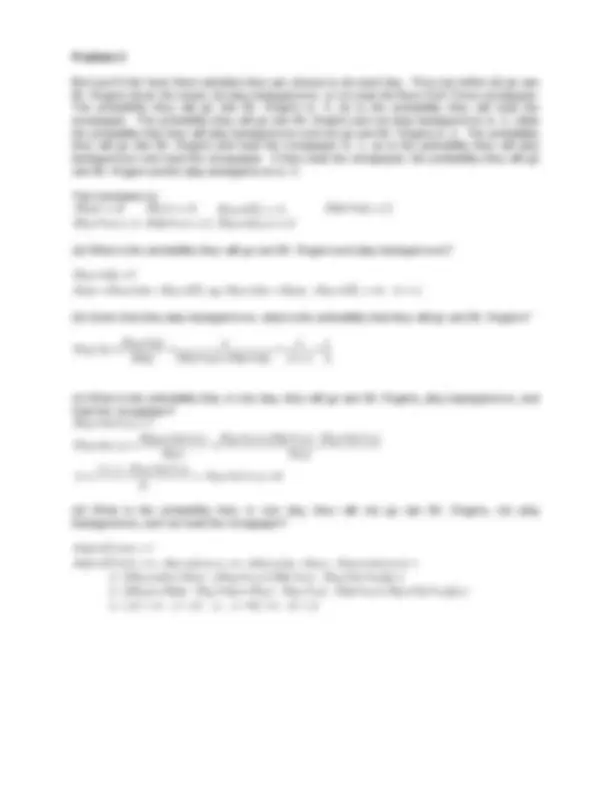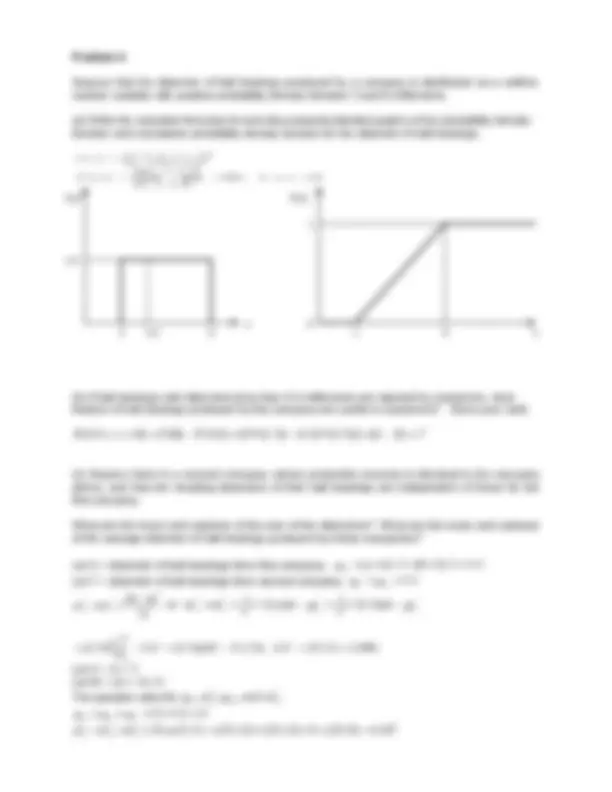





Study with the several resources on Docsity

Earn points by helping other students or get them with a premium plan


Prepare for your exams
Study with the several resources on Docsity

Earn points to download
Earn points by helping other students or get them with a premium plan
Community
Ask the community for help and clear up your study doubts
Discover the best universities in your country according to Docsity users
Free resources
Download our free guides on studying techniques, anxiety management strategies, and thesis advice from Docsity tutors
Statistics problems from an economics 204 class at davidson college, fall 2002. The problems involve calculating mean, standard deviation, interquartile range, coefficient of variation, and probabilities from given data sets. The document also includes formulas and graphs for probability density functions and cumulative probability density functions.
Typology: Exams
1 / 7

This page cannot be seen from the preview
Don't miss anything!




Name:
Statistics Davidson College
Economics 204, Fall 2002 Mark C. Foley
Suggested Solutions
Median 78
Mean 76.
90s 1
80s 13
70s 9
< 70 10
N 33
Problem 1
Consider the following sample data.
order: 6 8 3 10 7 2 5 4 1 9
(a) Calculate the mean, standard deviation, and interquartile range.
10
1
i
i
2
2
1
2
2
n
i
i
X
, so
2 sX sX
3
obs obs
n Q
th
th
15.9 s+ .25(16.8 – 15.9) = 16.
1
obs obs
n Q
st
st
(b) Calculate the coefficient of variation. Briefly explain why the coefficient of variation is useful
in comparing the variability of two or more variables.
x
s CV
Dividing the standard deviation by the sample mean accounts for the magnitude of the
variable’s values and removes the effect of units of measurement. CV is a unit-free indicator of
the standard deviation of a variable’s values, as a percentage of the sample mean.
(c) Fill in the non-shaded cells in the following table with the percent of population members that
lie within the given standard deviations from the mean.
Standard Deviations from the Mean
Empirical Rule
(rule of thumb)
68% 95% 99% or
almost all
Tchebychev’s Rule 55.556% 75% 84% 88.889%
For any population, 100(1-1/m
2 )% of observations lie within m standard deviations of the mean.
2 )% = 55.556%
2 )% = 75%
2 )% = 84%
2 )% = 88.889%
(d) Tires of a particular brand have lifetimes with mean 29,000 miles and standard deviation
3,000 miles. Find a range in which it can be guaranteed that 75% of the lifetimes of tires of this
brand lie.
100(1-1/m
2 )% = 75%, so (1-1/m
2 ) = .75, so 1/m
2 = .25, so m
2 = 4, so m = 2.
(29,000 – 2(3000) , 29,000 + 2(3000) ) = (23000, 35000)
Problem 3
Bert and Ernie have three activities they can choose to do each day. They can either (a) go see
Mr. Rogers down the street, (b) play backgammon, or (c) read the New York Times newspaper.
The probability they will go see Mr. Rogers is .4, as is the probability they will read the
newspaper. The probability they will go see Mr. Rogers and not play backgammon is .3, while
the probability that they will play backgammon and not go see Mr. Rogers is .2. The probability
they will go see Mr. Rogers and read the newspaper is .1, as is the probability they will play
backgammon and read the newspaper. If they read the newspaper, the probability they will go
see Mr. Rogers and/or play backgammon is .5.
This translates to:
P ( a ). 4 P ( c ). (^4) P ( a b ). 3 P ( b a ). 2
P ( a c ). 1 P ( b c ). 1 P ( a b | c ). 5
(a) What is the probability they will go see Mr. Rogers and play backgammon?
P ( a b )?
P ( a ) P ( a b ) P ( a b )so P ( a b ) P ( a ) P ( a b ). 4 . 3 . 1
(b) Given that they play backgammon, what is the probability that they will go see Mr. Rogers?
Pb Pb a Pb a
Pa b Pa b
(c) What is the probability that, in one day, they will go see Mr. Rogers, play backgammon, and
read the newspaper?
P ( a b c )?
Pc
Pa c Pb c Pa b c
P c
P a b c P a b c
Pa b c
Pa b c
(d) What is the probability that, in one day, they will not go see Mr. Rogers, not play
backgammon, and not read the newspaper?
P ( a b c )?
P ( a b c ) 1 P ( a b c ) 1 [ P ( a b ) P ( c ) P (( a b ) c )]
1 [ P ( a b ) P ( c )( P ( a c ) P ( b c ) P ( a b c ))]
1 [ P ( a ) P ( b ) P ( a b ) P ( c ) P ( a c ) P ( b c ) P ( a b c ))]
1 [. 4 . 3 . 1 . 4 . 1 . 1 0 ] 1 . 8 . 2
Problem 4
Assume that the diameter of ball bearings produced by a company is distributed as a uniform
random variable with positive probability density between 3 and 8 millimeters.
(a) Write the complete formulas for and draw properly-labeled graphs of the probability density
function and cumulative probability density function for the diameter of ball bearings.
otherwise
x f x 0 ,
1 / 5 , 3 8 ( )
(^) ^ ^
1 , 8
, 3 8
0 , 3 ( ) 8 33 53
x
x
x F x bx a^ a x x
(b) If ball bearings with diameters less than 4.5 millimeters are rejected by customers, what
fraction of ball bearings produced by this company are useful to customers? Show your work.
P ( 4. 5 x 8 ) F ( 8 ) F ( 4. 5 )[ 5 ( 1 / 5 ) ( 1. 5 )( 1 / 5 )][ 1 . 3 ]. 7
(c) Assume there is a second company whose production process is identical to the company
above, and that the resulting diameters of their ball bearings are independent of those for the
first company.
What are the mean and variance of the sum of the diameters? What are the mean and variance
of the average diameter of ball bearings produced by these companies?
2 2 2 b a
X Y
8
3
2 2
8
3
2 2 2 2 X Y x f ( x ) dx X x ( 1 / 5 ) dx X
3
( 1 / 5 )
2 3 3 2
8
3
3
x
Let Z = X + Y
Let W = (X + Y) / 2
The question asks for ,^ , ,.
2 2
Z Z W W
Z X Y
2 2 2
Z X Y
F(x)
3 8 x
1
0
f(x)
x
3 8
1/
S I
CovS I
Savings and income are weakly (.234 is much closer to 0 than it is to +1), positively correlated.
That is, there is a slight LINEAR association between savings and income, a slight tendency for
high values of S to be associated with high values of I and vice versa.
(e) If expenditure is defined as income minus savings, what is the variance of expenditure?
Let E = I – S.
2 2 2 CovI S E S I